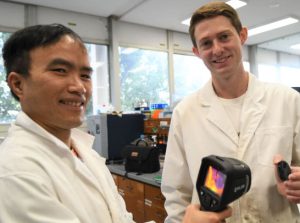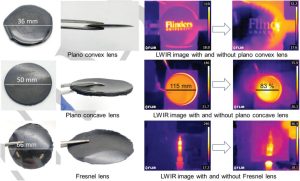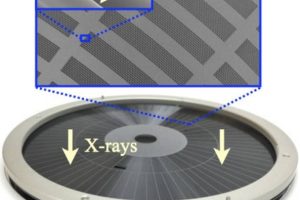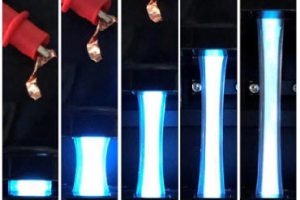
OK, OK, it might not be a replacement at the high-end, but ’67-poly(S-r-CPD)’ is black to visible light, and passes both medium and long-wave infra-red.
“It has the potential to expand the use of thermal imaging to new industries which were previously limited by the high cost of germanium or chalcogenide lenses,” said Flinders researcher Sam Tonkin (right in photo).
The polymer, which can be used for cast lenses as well as injection moulded lenses, is made from reacting monomers of sulphur and cyclopentadiene, using a molten-gaseous (respectively) technique invented by the team. The result “has the highest long-wave infra-red light transparency ever reported for a plastic”, according to the university.
Increasing the amount of sulphur in the molecule usefully increases refractive index (sulphur-containing polymer IR lenses are not a new idea) but, said Flinders, a maximum of 50% sulphur seemed to be the limit.
 Images with (right column) and without (2nd right) polymer secondary lenses of three types – A camera with a polymer primary lens is in the pipeline
Images with (right column) and without (2nd right) polymer secondary lenses of three types – A camera with a polymer primary lens is in the pipeline
“The practical maximum sulphur is 67% by mass,” Flinders chemist Professor Justin Chalker told Electronics Weekly.
The issue is, that increasing sulphur levels, however well chemically-bound, eventually cause S8 molecules to form spontaneously, making lenses cloudy as they age – some new batches of 67-poly(S-r-CPD) had traces of crystalline S8.
Quantum mechanical calculations revealed how and why the material is transparent to the mid and long infra-red wavelengths. “This material was designed to have a wide array of potential applications from space to military, civil and aerospace,” said team computational chemist Le Nhan Pham (left in top photo).
‘Thermal imaging and clandestine surveillance using low-cost polymers with long-wave infrared transparency‘ describes the work in Advanced Optical Materials, and can be read in full without payment.
Image note: All images provided by Flinders University
 Electronics Weekly Electronics Design & Components Tech News
Electronics Weekly Electronics Design & Components Tech News



